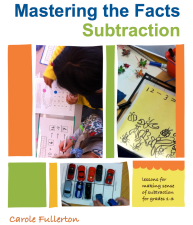Hello to the fantastic parents and teachers at Eagle Harbour! What a fun morning I had working with you and your children… 🙂
I am so pleased that we had the chance to talk about the changes in the new math curriculum and to watch how making sense of number and using strategies like “add tens, add ones” or “take from one and give to the other” can go a long way in supporting children in truly understanding what it means to join groups…
I promised, in the last few rushed moments, to post some materials here for you to access and use with your children. First, the Math Tool Kits and the games to play with your children can be found by clicking here. They contain all the materials you need to support your elementary-aged child in mastering the facts in a visual way – they also help children to “see” how the strategies of “add ten and add ones” and “take from one and give to the other” work, when using the pink and blue ten frame cards.
 A couple of you asked for support materials to read to make sense of this for yourselves. If you were up to reading a whole book (grin! 🙂 ) then one I would highly recommend are the resources by John Van de Walle, who has written Teaching Student Centered Mathematics, for Grades K-2, 3-5 and 5-8. The books are available through Amazon.ca or through Chapters.ca. If you’d prefer a small excerpt, here are 3 pages to read drawn from the grades 3-5 book, which describe what Van de Walle calls invented strategies for addition and subtraction. These are the ones we modeled and talked about today – consider it a cheat sheet for helping your kids!
A couple of you asked for support materials to read to make sense of this for yourselves. If you were up to reading a whole book (grin! 🙂 ) then one I would highly recommend are the resources by John Van de Walle, who has written Teaching Student Centered Mathematics, for Grades K-2, 3-5 and 5-8. The books are available through Amazon.ca or through Chapters.ca. If you’d prefer a small excerpt, here are 3 pages to read drawn from the grades 3-5 book, which describe what Van de Walle calls invented strategies for addition and subtraction. These are the ones we modeled and talked about today – consider it a cheat sheet for helping your kids!
And for those of you who’d like to learn about what this looks like with long division, read on…
Division is about sharing. The traditional algorithm focuses not on sharing but on numbers “going into” other numbers. A strange thing even to visualize, no? The new way of modeling and recording long division is based on the idea of sharing, and depends on a child knowing only the multiplication facts of 1, 2, 5, and 10… yes, the easy ones!! 🙂
Here’s how it goes. Imagine you have 359 candies on a table, and you have 16 children who want to share them. How many would you give to each child to start? 1, 2, 5 or 10 each? Most would say 10 each, just to make everyone happy. So if we give away ten each, that’s 16×10 or 160 candies that are gone. (See below)
To figure out how many are left, we need to subtract 160 from 359 (or find the difference between them). We can do that by adjusting the top number – because if you were subtracting from 360 that would be so much easier… To do that you have to add one to 359, find the difference (360-160=200) and then take away that 1 you added before. You now have 199 candies left, and the kids are still hungry, so you continue, giving away sets of candies to each child until there are too few to divide up. What one does with the “remainder” in this case is a great conversation… Check out a full-sized illustration of this task by clicking here: long division – by sharing .
Here’s another example, with larger numbers:  Van de Walle does another example using larger numbers (sharing in multiplies of 1, 2, 5, 10 and then 20, 50 and 100) in this excerpt from his book. As you can see, there are lots of ways of doing this – and many ways to be right. What a relief! 🙂 Carole
Van de Walle does another example using larger numbers (sharing in multiplies of 1, 2, 5, 10 and then 20, 50 and 100) in this excerpt from his book. As you can see, there are lots of ways of doing this – and many ways to be right. What a relief! 🙂 Carole







